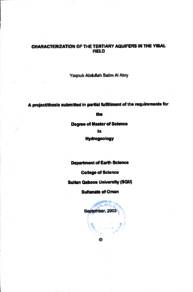Document
Chemostratigraphy (carbon and oxygen isotopes), outcrop based gamma ray measurements and facies analysis of the natih formation in Wadi Nakhr (Jabel Akhdar area) north Oman
Publisher
Sultan Qaboos University
Gregorian
2017
Language
English
English abstract
The Late Albian-Early Turonian Natih Formation and its time-equivalent formations in the Gulf Region are one of the most studied prolific hydrocarbon reservoirs in the Middle East. However, despite the large number of the studies dealing with sedimentology, sequence stratigraphy, paleontology and diageneses, the lack of precise chronostratigraphic dating as well as the lack of wireline logs in the outcrop is notably lacking. This hamper high resolution surface to subsurface correlation and dating. The most complete C-isotope curve covering the entire Natih Formation comes from subsurface data, whereas other isotopic curves have been published recently for Adam Foothill region. This study aims to develop the first high-resolution chemostratigraphy, biostratigraphy, facies analysis and gamma ray measurements for the carbonates of the Natih Formation in Wadi Nakhr. By integrating all methods used, the section has been divided into four units A, B, C and D according to Van Buchem division which are closely correlated to the Natih Members nomenclature developed in previous works. Following detailed sedimentary logging and microfacies analysis, seven microfacies associations have been identified, representing a range of carbonate sedimentary environments from platform interior to intrashelf basin setting. Carbon isotope curve of the studied section can be easily correlated with the marine C reference curve from the English Chalk except for the interval represented by the member B which is characterized by low isotopic values. The major two positive picks in 813C profile which corresponding to Natih C and D have been identified as of middle Cenomanian age which is confirmed by the presence of typical large foraminifera. The low value which is corresponding to unit B can be well correlated locally with Oman carbon isotope curves and can be dated as middle to Late Cenomanian age which is confirmed by ammonite found in the studied section. The top part of the section (unit A) can be dated as Late Cenomanian to Early Turonian age based on C-isotope stratigraphy and by the occurrence of Hippuritid rudists.
Finally, the gamma ray response match's very well the gamma ray profiles from subsurface record and together with C isotope stratigraphy as a useful tool for high resolution correlation
The findings of this study hopefully will have dramatic importance for reservoir correlation and hydrocarbon exploration in the Natih Formation across Oman. Furthermore, the isotopic data would help in regional correlations with time equivalent reservoir formations of the Arabian plate.
Description
Thesis
Member of
Resource URL
Arabic abstract
يعد تكوين ناطح والذي ترسب في أواخر الألبيان أوائل التورونيان ومكافئاته في وقت الترسب في الخليج العربي من أكثر الخزانات الهيدروكربونية غزارة في الشرق الأوسط. وعلى الرغم من أن العدد الكبير من الدراسات التي تتناول هذا التكوين في مجال علم الرسوبيات، وعلم الطبقية، وعلم الأحافير وعلم التغيرات يوجد نقص في علم الطبقات الكيميائي وكذلك قياس الإشعاعات في هذا التكوين. وهذا يعوق الدقة في الربط بين هذا التكوين في سطح الأرض وباطن الأرض. ويأتي منحنى النظائر الكربون الأكثر اكتمالا لهذا التكوين من البيانات المجمعة من باطن الأرض. مؤخرا تم نشر منحنيات النظائر المختلفة لهذا التكوين ولكن فقط لمنطقة جبال أدم. وتهدف هذه الدراسة إلى تطوير أول تحليل كيميائي عالي الدقة، وتحليل علم الطبقات الأحيائي، وتحليل السحنات وقياس أشعة جاما لهذا التكوين في وادي نخر. من خلال دمج جميع الأساليب المستخدمة، تم تقسيم تكوين ناطح إلى أربع وحدات C , B , A وDوالتي ترتبط ارتباطا وثيقا مع تقسيمات تكوين ناطح التي تم تطويرها في الأعمال السابقة. وبعد التحليل التفصيلي للسحنات الصغيرة والرسوبيات، تم تحديد سبع سحنات والتي تمثل مجموعة من البيئات الرسوبية الكربونية من الحوض الداخلي إلى الحوض الخارجي ويمكن ربط منحنى الكربون النظيري لتكوين ناطح مع منحنى الكربون الطباشيري الإنجليزي باستثناء الوحدة B والتي تتميز بقيم نظائر منخفضة. وقد تم التعرف إلى اثنين من القيم الإيجابية في المنحني الكربوني النظيري والذي يقابل الوحدات C وD والتي ترسبت في منتصف العصر السنومانيان والذي أكدت علية وجود أحافير كبيرة من الفورمانيفيرا. بينما القيمة المنخفضة والتي تقابل الوحدة B يمكن أن تكون مرتبطة بشكل جيد محلية مع منحنيات النظائر الكربونية لعمان، ويمكن تأريخها من منتصف إلى أواخر العصر السنومانيان والذي أكده وجود أحفورة الأمونايت في القسم المدروس. أما بالنسبة للقسم العلوي من الدراسة والذي يمثل الوحدة A يمكن تاريخها إلى أواخر السنومانیان وأوائل التورونیان مقرونة بنظائر الكربون ولوجود أحفورة الهييوريتيس رودیست. وأخيرا فإن أشعة الجاما للمنطقة المدروسة تتطابق جيدة مع أشعة جاما المسجلة لتكوين ناطح تحت سطح الأرض جنبا إلى جنب مع منحنی نظائر الكربون والتي تعتبر أداة مفيدة للربط عالي الدقة مع مختلف أماكن تواجد هذا التكوين. ومن المأمول أن تكون هذه الدراسة ذات أهمية كبيرة للربط بين مكامن النفط والاستكشاف الهيدروكربوني لتكوين ناطح في جميع أنحاء السلطنة. علاوة على ذلك فان بيانات النظائر تساعد في الربط الإقليمي لهذا الخزان النفطي المهم.
Category
Theses and Dissertations



